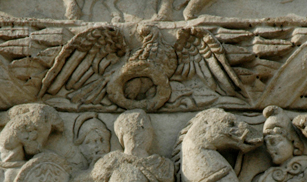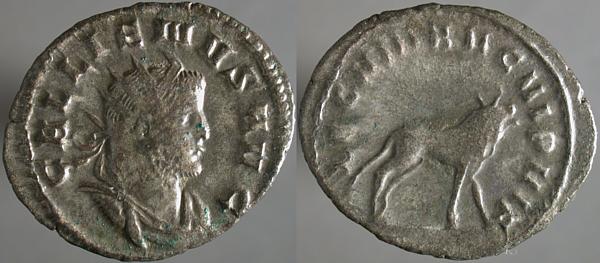
This page created 29 March 2014, and last modified: 29 October 2015 (silver-blue eagle commentary added)

The Divitenses Gallicani is listed (18.21 in Ingo Maier's numbering scheme) as the tenth of the legiones comitatenses under the Magister Militum per Thracias. Its shield pattern (17#5), under the matching label (17.e) Divitenses Gallicani, is shown in various manuscripts as below:

The shield pattern has a white main field, and a yellow boss encircled by a red band. A bird, possibly a not so-well rendered eagle, is depicted in blue (more white in M) at the 12 o'clock position, with wings outspread and facing left (right in B, which being printed, reverses the facings of all the shields). At the six o'clock position, also facing left (right in B) is a blue (brown in M, half-brown in B) straight-horned ruminant of some description, probably a bovid (but a hound instead in B). The image of an eagle above a central ring (which would thus surround the shield's boss) brings to mind other examples of Roman imagery such as in the Arch of Galerius, where an eagle grasping a wreath of victory is shown over Galerius' (defaced) head:

Three other Legiones comitatenses units under the Magister Militum per Thracias, the Tertiodecimani (18.16), the Quartodecimani (18.17), and the Constantini seniores (18.20), have very similar patterns to that of the Divitenses Gallicani, as can be seen below from the following patterns taken from the Paris manuscript:

Given the seemingly unrelated nature of the names of units, this suggests a simultaneous issuance when all four were perhaps detached from their parent units to join a new formation (such as that of the Magister Militum per Thracias).
There is just one other unit named Divitenses listed in the Notitia: the Divitenses seniores (98/9.23) under the Magister Peditum in his Italian command; its shield pattern is unrelated, which would be no surprise if the Divitenses Gallicani was given a new pattern upon joining the command of the Magister Militum per Thracias. The word Divitenses means "of/from Divitia" (Castellum Divitia, modern Deutz in Germany), which was re-established by Constantine I in ca. 310 AD as a bridgehead across the Rhine opposite Colonia to better guard the Gallic frontier. Given the lack of a Divitenses iuniores in the Notitia, it may be that the Divitenses Gallicani was called the Divitenses iuniores before it was moved from Gaul to Thrace, and was thereafter given the Gallicani moniker; however, since there are many instances of seniores-iuniores pairs in the Notitia that also have a third Gallicani partner, it is probably more likely the Divitenses iuniores is simply missing from the document.
Units known to have occupied Divitia in the 4th century include (detachments of) both Legio VIII Augusta and Legio II Italica. Since there are inscriptions (e.g. ILS 2346, ILS 2777) in Italy mentioning Legio II Italica Divitensium, then it appears the Divitenses Gallicani could also be a descendent of Legio II Italica, raised by Marcus Aurelius in the 2nd century just as the Divitenses seniores clearly are. Limitanei detachments of Legio II Italica are listed (145.25-27) in the Notitia as garrisoning several places in Noricum, under the Dux Pannoniae primae et Norici ripensis, while other non-limitanei units descended from Legio II Italica in addition to the Divitenses unit(s) appear to be the Secundani Italiciani (98/9.109) under the Comes Africae and the Lanciarii Lauriacenses under the Comes Illyricum (102/5.109).

However, since the emblem of Legio II Italica was a wolf, while that of Legio VIII Augusta was a bull (see coin above), the fact that a bovid appears to be represented in the shield pattern greatly increases the probability that the Divitenses Gallicani was actually descended from Legio VIII Augusta instead. Silver bulls were popular as figures used for unit standards under the republic, and may not have been entirely superseded when aquilae were introduced under Marius, as Imperials coins of Legio X gemina are known in which a bull is depicted surmounting a vexillum (banner) standard.
1. Ingo Maier; "Appendix 4: Numeration of the new edition of the compilation 'notitia dignitatum' (Cnd)"; last accessed 26 October 2015. See also for here for numbering examples. Return
2. Marcus Tullius Cicero ("Cicero"); "In Catilinam", 1.9.24; available here in Latin and here in English (last accessed 29 October 2015). Return
3. A.H.M. Jones; "The Later Roman Empire, 284-602; A Social, Economic, and Administrative Survey"; Blackwell, Oxford, 1964; vol. 3 of 3, at p 14, note 3. Return
4. Raffaele d'Amato; "Arms and Armour of the Imperial Roman Soldier: From Marius to Commodus"; Frontline, Barnsley, 2009; at p 46. Return

Return to the Notitia alphabetical unit list page.
Return to my Notitia index page.